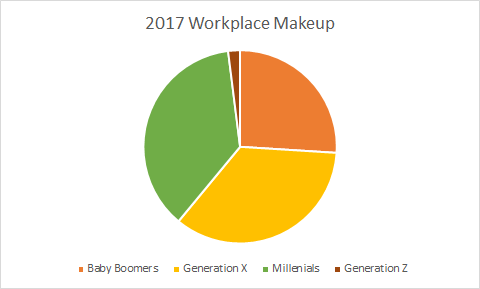In today’s workplace, there can be up to four generations working together on a project. While this collaboration is an excellent opportunity for generating new perspectives, conflicts can arise as different personalities clash. Members of the same generation grew up with similar values and experiences and thus tend to perform best under particular management styles. Worker cohorts also tend to share preferences for compensation and work environments, raising implications for employers in structuring their organizations.
Although members of the same generation might generally share values and experiences, employers must be careful not to discriminate or stereotype individuals based on their age. Here we’ll take a look at generational preferences as well as the laws employers must be aware of to avoid potential legal liability.
Working Generations
Sociologists don’t always agree on the birth years establishing the separate generations. However, they and popular culture tend to recognize generations spanning approximately 15-20 years.
Here’s a chart showing the relative portion of the U.S. workforce falling into each of the recognized working generations:
Baby Boomers
The members of the Baby Boomer generation are loosely defined as being born anywhere from the mid-1940s to the early 1960s. They are referred to as “baby boomers” due to the increase in birth rate during these years. Baby Boomers share the experiences of the economic boom in the aftermath of WWII, the development of color television, the Cold War, the first walk on the moon, and the Vietnam War. They also lived through several civil rights movements.
In the workplace, Baby Boomers are seen to value company loyalty, strong work ethics, a steady career path, and compensation. Baby boomers are currently retiring at a rate of 100,000 employees per day. However, due to the timing of the last recession, many cannot afford to retire and are instead seeking part-time jobs for an ongoing income stream. With advances in healthcare, the overall U.S. population is growing older, with projections for the population of older Americans to double by 2060. According to the Bureau of Labor Statistics, “As the baby-boom generation ages, the share of workers age 55 and older—a cohort with a low labor force participation rate—is projected to grow to 24.8 percent in 2026. This share is up from 22.4 percent in 2016 and 16.8 percent in 2006.”
Generation X
Generation X (Gen X) follows the Baby Boomer generation and precedes the Millennials. They were born between the mid-1960s and the early 1980s. Generation X members are also sometimes referred to as “baby busters” because of the drop in the fertility rate during these years. Commonly shared experiences include living through the 9/11 terrorist attacks and the widespread adoption of the Internet and cellular phones.
These individuals grew up during a time when women, especially mothers, were increasingly participating in the workforce. This generation (on the whole) values work-life balance more than previous generations. Members of this generation also value stability, personal advancement, and job satisfaction. In the workplace, Generation X members are often considered to be independent, resourceful, and adaptable.
Millennials
Millennials (or Generation Y)/Gen Y) are currently the largest generation active in the American workforce. Members of this group were born between the early 1980s and mid-late 1990s. Millennials often engaged in more precarious work in the aftermath of the Great Recession. This generation doesn’t remember offices without computers and has been characterized as having increased familiarity with technology, communications, and media.
In the workplace, Millennials generally prefer a flat corporate culture, an emphasis on work-life balance, and a socially conscious workplace. Millennials search for environments with meaningful work and opportunities to express creativity. This group benefits the most from immediate feedback. Millennials value free flow of communication and close relationships with supervisors. They are more likely to switch careers than previous generations.
Millennials are the most diverse generation. Due to immigration, this population is increasingly likely to be born outside the United States with a first language other than English. By 2020, Millennials should make up half of the global workforce.
Generation Z
The members of Generation Z (Gen Z) were born from the mid-1990s into the 2010s. They are deeply familiar with technology and social media, having never known a world without mobile phones and digital music and videos. Many came of age during the Great Recession, which has resulted in them being independent and entrepreneurial. Members of this generation typically have a more global perspective and comfort with technology-based interactions. However, they still value person-to-person contact in the workplace. Although Generation Z has not yet gained much work experience, they do tend to have large networks as a result of omnipresent social media. They highly value personal fulfillment in their careers.
What Unites These Generations in the Workplace?
There are several values that employees universally appreciate. In the workplace, individuals of all ages value respect, communication, mentorship opportunities, positive feedback, exchanging ideas, and being able to see the big picture. Employers should keep these values in mind when managing a multigenerational workplace, but might need to adapt their approaches based on individual or subgroup differences
Beware: Age Discrimination
Passed in 1967, the Age Discrimination in Employment Act (ADEA) is a federal law that prohibits age-based discrimination in employment. This law covers employees and job applicants age 40 and older and does not protect younger individuals from preferential treatment toward older workers. The ADEA covers employers with 20 or more employees, employment agencies, government employers, and unions.
Many states also have laws prohibiting discrimination based on age. Some, unlike the ADEA, protect employees even younger than 40 years old. The New York State Human Rights Law is one such law. It protects employees and applicants from discrimination based on numerous protected categories, including age beginning at age 18.
Age discrimination claims can arise out of hiring, firing, promotion, compensation, or any other aspect of employment. This includes harassment.
Examples of age discrimination could include:
- Assuming only younger employees can handle technology;
- Pressuring older employees to retire;
- Not allowing an older employee to pursue new training; or
- Refusing to hire or promote an otherwise qualified employee based on age.
Although the above examples seem relatively straightforward, sometimes subtle actions can lead to discrimination claims. If employers have any questions, they should consult with an experienced employment lawyer.
Special thanks to Erin Killian for her substantial contributions in drafting this article. As of this writing, Erin is a 2L student at the University at Buffalo School of Law and law clerk at Horton Law.




You must be logged in to post a comment.